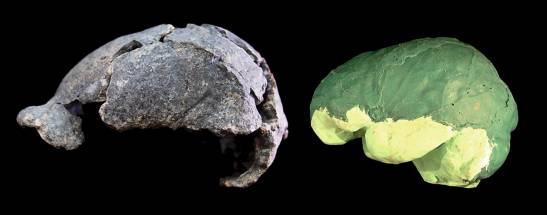Paleoneurologist Emiliano Bruner and archaeologist Sileshi Semaw, from the National Center for Research in Human Evolution (CENIEH), published an article in the American Journal of Biological Anthropology on the 1.5 million-year-old DAN5/P1 skull, found at the Ethiopian site of Gona, whose cranial morphology indicates that it belongs to the species Homo erectus and, in particular, to its first African stage, which is sometimes identified by the name Homo ergaster.
The results of the study of this fossil, very small for these groups of hominids, suggest that the brain morphology does not show distinctive characteristics of the human race. It also has similar proportions to australopithecines or species whose evolutionary position —and belonging to the human lineage— has not yet been established, as is the case with Homo habilis.
This fossil has similar proportions to australopithecines or to species whose evolutionary position and membership in the human lineage have yet to be established.
“The DAN5/P1 skull is rounder and less elongated than that observed in later Homo erectus individuals, but this is likely due to the architecture of the skull rather than certain proportions of the cerebral cortex,” says Dr. investigator.
This analysis confirms that evidence for a clear boundary for the origin of human brain anatomy is still lacking, at least in light of the current fossil record. Most of the differences between early human species – and even between humans and australopithecines – in brain anatomy are primarily associated with differences in average brain size.
The difficulty in finding brain characteristics associated with the evolution of the genus Homo, in addition to size, may be due to the absence of macroscopic differences in the cortex, limitations of fossil samples or difficulties in interpreting brain morphology. of the internal impressions of the skull.
Most of the differences between early human species in brain anatomy are associated with differences in average brain size.
“Of course, this does not exclude the possibility that the origin of the human brain could be associated with changes that cannot be detected in its general anatomy, such as changes that occur at the level of cells and tissues, of neural connections or of neurotransmitters,” he adds. the main author.
This study was carried out in collaboration with the American universities of Columbia University (New York), Midwestern University (Glendale), Southern Connecticut State University (New Haven) and Stone Age Institute (Gosport). The same team published, a year ago, a complete study in the skull of the same individual.
Reference:
Bruner E et al. “The endocast of Dana Aoule North (DAN5/P1): A 1.5 million year old human braincase from Gona, Afar, Ethiopia”. American Journal of Biological Anthropology (2023)
